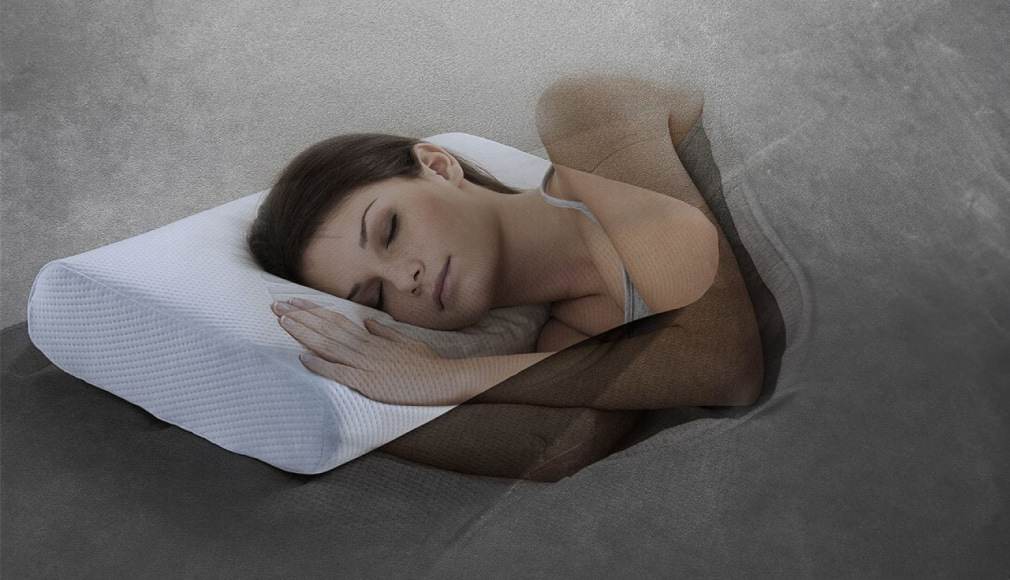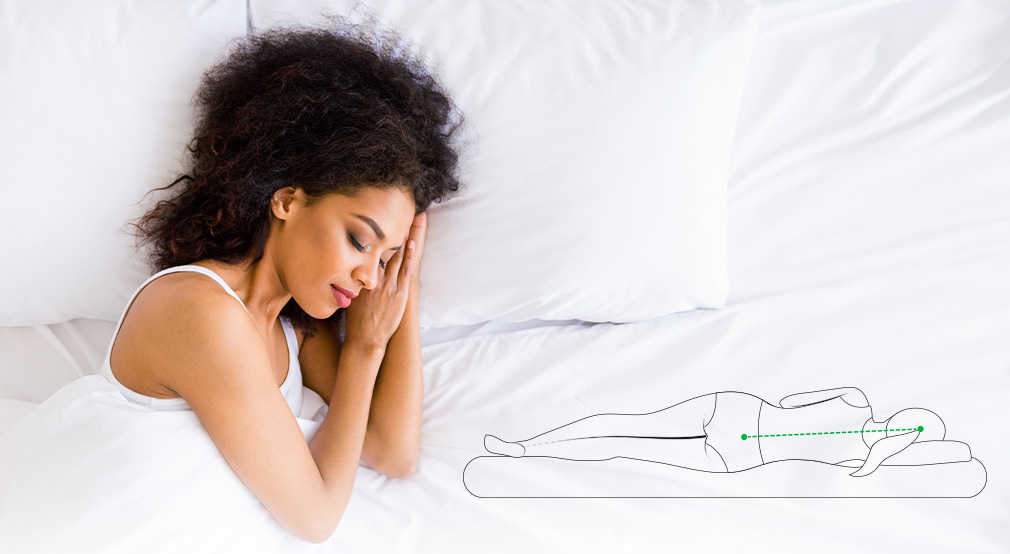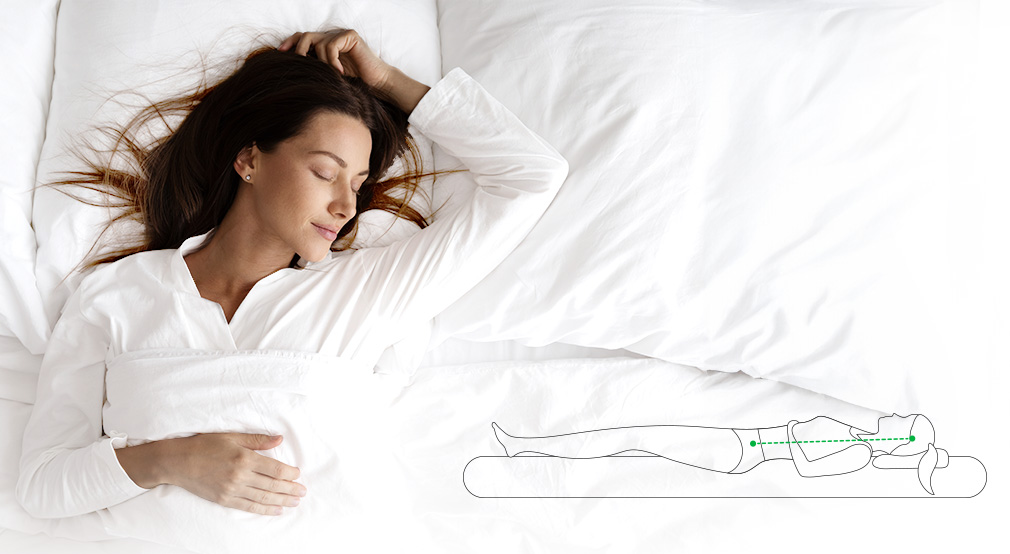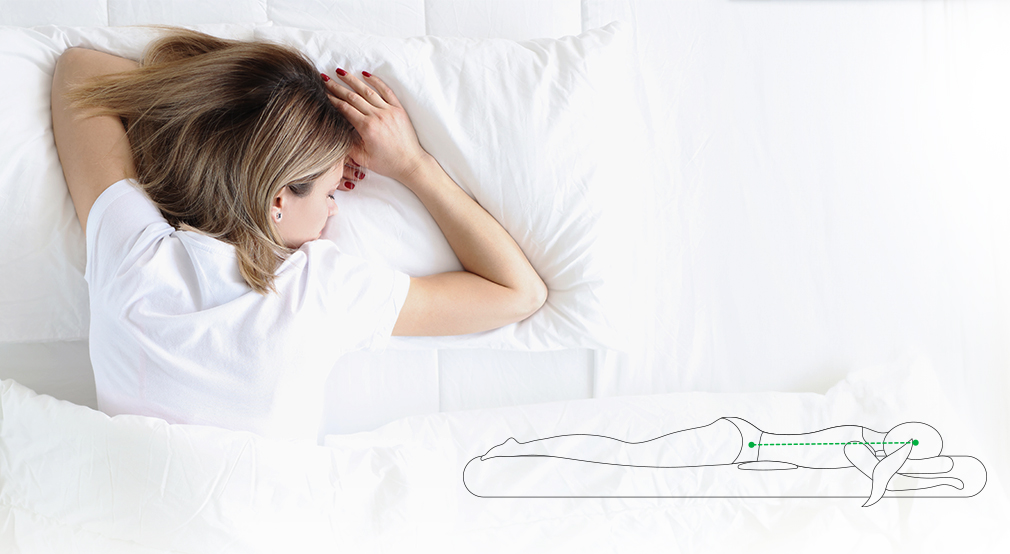Types of Pillows: Everything You Need to Know to Choose the Right Pillow
-
Categories :
Bedroom



Considering buying a new pillow?
If you’ve been having regular pillow fights lately–and not just the ones with your dogs or kids–it’s probably high time to ditch that lumpy has-been and get yourself a fresh piece of night-time noggin real estate!
Seriously, uncomfortable pillows are the worst. And it’s not just an inconvenience.
Aside from your mattress, your pillow is a crucial factor in helping you sleep well, which in turn has a profound effect on your physical and mental health and wellbeing.
But trying to choose the perfect pillow can be almost as daunting as hunting down the ideal mattress.
Hundreds of options...non-stop sales jargon...and that awkward shopping experience trying to test out a product that’s meant for your most private and personal space.
It’s no wonder many of us resort to picking the first pillow that seems to pass the ‘squish test’.
But there’s a lot more to choosing a good pillow than first impressions.
Knowing your way around the various types of pillows is a good place to start if you want to find the best fit to give you both the comfort and support you need for a great night’s sleep.
We’ve put together a simple yet comprehensive guide to all the common and popular types of pillows, tips to help you choose a pillow that’s right for your individual needs, as well as answers to other practical pillow questions.
Whether you’re shopping for a pillow for yourself or a family member, we’ve covered all the basics to help you make the best choice to secure your spot in dreamland.
Let’s jump in.
Pillows come in a huge variety of shapes and sizes, with a hundred different options in cover materials, fabrics and special treatments.
But when we’re talking about ‘pillow types’ on a basic level, it comes down to what’s inside the pillow: the filling.
The most common fillings for pillows manufactured in South Africa include feather and down pillows, memory foam, latex, microfibre and polyester.
Since there are a lot more options available in stores and online, we’ve broadened that list to look at 10 of the most popular types of pillows, along with their overall pros and cons.
Feathers are still one of the most popular pillow fillings around.
Pillows are filled with feathers from the wings and backs of ducks and geese, usually with a small percentage (5-10%) of down fibres from the soft underside of the birds to give a bit of extra softness.
The feathers, quill and all, provide quite a firm and supportive filling.
While they won’t naturally contour to your head and neck, you can manually shift them around to have more support where you need it.
The feathers do tend to flatten out as you sleep, so may require some extra plumping during the night.
Since they are breathable and don’t retain heat, feather pillows retain a cool feel, which is great for those who tend to sleep warm.
It’s important that the pillow has a high quality casing to prevent the quills poking you in your sleep.
Feather pillows are also fairly hefty (which is great for pillow fights, especially if you want that classic ‘end scene’ of a room full of feathers).
Down is a very light, soft, fluffy cluster taken from the chest and underbelly of ducks and geese.
Down pillows are fairly expensive but are exceptionally durable, soft and luxurious—you’ll feel like you’re sleeping on a cloud, or maybe a marshmallow!
The level of firmness and support varies depending on the density of the fill (which also affects the price).
The down naturally compresses as you lie on it, but reverts to its natural loft afterwards. Down can also be mixed with feathers in different ratios to adjust the level of firmness and support.
Down is known for its insulation properties, keeping you warm and cosy. If you prefer a cooler pillow for summer, down may not be the best choice.
If you’re worried about allergies, synthetic down (usually made from polyester) is a sneeze-free alternative that mimics the soft comfort of down, with a friendlier price-tag too. While the man-made version doesn’t quite hit the same levels of natural support, insulation and resilience, it comes pretty close in comfort and durability.
Memory foam has gained massive popularity in the bedding world thanks to its unique viscous qualities which respond to body heat.
Memory foam moulds itself around your body to provide highly customised and consistent support, reverting to its original shape when the pressure is removed.
Memory foam pillows come in two main varieties: solid core (single piece) memory foam or shredded memory foam.
Solid core pillows come in a variety of firmness levels, but on the whole they have a firmer feel than most other pillow types.
Shredded (or chipped) memory foam pillows have a softer feel and allow you to adjust the height and support level by shifting the foam chips around.
Memory foam on its own can tend to sleep a little warm, but good quality, breathable casings can make a big difference.
Some memory foam pillows also incorporate cooling gel within the pillow filling or in an outer layer to improve temperature regulation.
Latex comes in natural, synthetic and blended forms. As with memory foam, latex pillows can also be in the form of a solid or shredded filling.
Solid latex pillows offer medium to firm support with a bouncy feel that is quite forgiving, while offering a consistent level of comforting support.
Shredded latex allows you to move the pieces around to customise the shape and feel of the pillow.
Latex is extremely durable and you can count on it to hold its shape for years when properly cared for.
Cotton pillows have been popular for a long time.
The cotton fibres can be packed in varying densities to offer different degrees of support from soft to firm, and offer excellent breathability for a cool and comfortable sleep.
On the downside, cotton pillows have become quite expensive, and do tend to shrink and lose their natural loft after months of use.
Polyester pillows are a widely available, low-cost option designed to mimic the feel of cotton.
They have a soft feel and don’t provide a lot of support, but may feel perfect for back and stomach sleepers.
Polyester is hypoallergenic, sleeps cool and doesn’t hold on to moisture or odours, but is prone to attracting dust mites.
The main downside of polyester is that it starts to lose its shape and integrity over time, becoming flat and potentially lumpy.
Microfibre is made from polyester which has been through a special process to create an extremely fine and tightly packed fibre.
Microfibre pillows are soft yet supportive, and offer a cost-effective option that’s also easy to clean and care for.
Compared to latex and natural fibres, microfiber pillows tend to trap more heat and can sleep a little warm in the summer months.
They may also lose their integrity and become lumpy with extended use, but are more durable than standard polyester pillows.
Hybrid pillows can be made up of many different combinations of the other fill materials mentioned here—the concept being to offer a ‘best of both worlds’ solution.
A combination of down alternative and shredded memory foam, for example, is one of the most popular types of hybrid pillows internationally.
In South Africa, hybrid varieties commonly combine different types of foam such as latex and memory foam, sometimes along with cooling gel, in various configurations to offer different levels of firmness and support in a single pillow.

Aside from cotton, manufacturers have experimented with a number of other organic fibres which offer a more natural and sustainable alternative to many traditional and synthetic pillow fillings.
Want the short answer? The best pillow is simply the one that gets you the best night’s sleep. No matter how many recommendations you find online, there is no one-size-fits all ‘best pillow’ that is going to suit everybody.
There are just too many subjective factors, habits and personal preferences involved. These include:
But aside from individual preferences, there are a few key factors that sleep experts agree on when it comes to judging a good quality pillow and whether it’s likely to get you that great night’s sleep.
Here are the top three:

Support - a pillow’s main function is to properly support your head and neck as you sleep. The best pillows will support your head in a way that allows your neck to stay in a neutral position, in line with the rest of your spine, without creating undue pressure on your head or your shoulders.
The level of support you need to achieve this will depend on your body dimensions, and your preferred sleeping position.
Breathability - airflow can be a very important factor in pillows for a few reasons. Becoming too warm and sweating while you sleep is not only a major deterrent to peaceful sleep, but a pillow that lacks breathability and stays damp inside will tend to attract bacteria and germs, and lose its inner integrity more quickly.
Resilience - this refers to a pillow’s ability to ‘bounce back’ and hold its original shape over time. Firstly, a pillow with good resilience allows you to easily change position through the night without disrupting your sleep since the pillow will quickly adjust to the new pressure areas to offer you the same level of support.
Secondly, the pillow is able to keep its integrity over a long span of time without becoming flat or lumpy, ensuring longevity.
Whatever material or filling combinations are used to achieve the results, pillows that score well on these three factors are likely to be quality products with the best chance of helping you get the quality sleep you need.
Your preferred sleeping position is one of the biggest factors that will affect your choice of pillow.
If you tend to switch positions through the night, then it’s best to pick a pillow for the position in which you normally fall asleep.

For side sleepers: you’ll need a pillow that’s thick enough to properly fill the gap from your neck to the outer edge of your shoulder, while allowing your head to sink in just enough to keep your neck in a neutral position, aligned with your spine.
The pillow should be firm enough to hold your head in a neutral position and help take the pressure off your shoulders, but not so firm that it ‘props’ your head up at an awkward angle, putting pressure on your neck.

For back sleepers: your pillow should offer just enough thickness and support to elevate your head slightly and fill in the gap under your neck to keep it in a neutral position with your spine.
The biggest mistake for back sleepers is choosing a pillow that’s too thick of firm for your build, causing your neck and head to be propped up at an unnatural angle. Relatively speaking, the best pillows for back sleepers are thinner and softer than those best for side sleeping.

For stomach sleepers: stomach-sleeping is not recommended since it puts the most strain on your back and neck.
(That’s why massage tables usually feature a face hole to keep the spine and neck in a neutral position).
Experts recommend trying to train yourself out of sleeping on your stomach, but it’s something you probably won’t be able to do overnight.
Many stomach-sleepers don’t use a pillow, but if you do prefer one, opt for a soft, thin pillow that won’t cause added pressure to your neck.
You could also try a wedge pillow or simply wedging a thin pillow under one side of your face to keep your head slightly propped up at a more neutral angle (many stomach-sleepers do this by lying on their arm, which is not ideal!).
Adding a thin pillow under your hips is another way to relieve some of the pressure on your lower back.
Whether you’re suffering from neck pain from an injury, a laptop-induced hunch or some unknown cause (perhaps your poor current pillow!), making sure you have a properly supportive pillow is one of the most vital steps in getting back to a happy normal.
The most important thing is that the loft and firmness of your pillow keeps your neck in line with the rest of your spine, and not elevated above it, whether you’re sleeping on your back or your side.
(If you’ve been sleeping on your stomach, that’s the first thing you’ll want to change if you’re struggling with neck pain or back pain!)
Sleep experts generally recommend a firmer mattress and pillow for individuals suffering from neck pain.
Cervical pillows are a great choice as they are specifically designed to provide extra neck support, and may also help to alleviate snoring, sleep apnoea and headaches.
The Visco Pedic Contour Memory Foam Pillow offers a medium-firm feel with high density memory foam providing superior support for your head and neck. The dual contours offer two height options, making it a comfortable choice for both back and side sleepers.
There are three main factors that will affect your ideal pillow firmness: your sleeping position, your mattress, and personal preference to some degree.
As mentioned above, side sleepers are more likely to need a medium-firm to firm pillow, since it needs to fill the larger gap between your shoulder and neck, and provide consistent support to prevent pressure on your shoulders while keeping your neck in a neutral position.
Back sleepers and stomach sleepers will do better with a softer, thinner pillow. One that’s too thick or firm will cause the neck to bend at an unnatural angle.
Aside from accommodating your sleep position, your pillow also needs to work in tandem with your mattress. A softer mattress allows your body to sink in more at the key pressure points, resulting in a smaller gap between your shoulders and neck when lying down, hence a thinner, softer pillow will be adequate to fill the gap.
Whereas a firmer mattress will call for a relatively firmer, fuller pillow since there is less ‘give’ with the mattress, and therefore a larger gap and more support needed from your pillow.
Even with these two points in mind, you’ll still need to check what level of firmness is right for your personal build and comfort levels. A pillow that’s too firm can cause some side-sleepers to experience ear pain and sensitivity after a few hours of contact, while back-sleepers may experience headaches.

When it comes to pillow filling materials, latex, memory foam and wool offer a relatively firmer feel.
Our Latex and Memory Foam Hybrid Pillow is also great for getting the best of both worlds with the firmer feel of memory foam and the softer bounce of latex, particularly if you tend to switch between back and side sleeping.
If you’re looking for something softer, you might want to look at a polyester, microfibre, cotton or kapok pillow, or check out our super plush and breathable Duck Feather Down Pillow.

First, be sure your child is ready to sleep with a pillow. Paediatricians recommend that parents only introduce a pillow to a toddler’s bed from 2 years upward , as pillows and loose bedding can increase the risk of sudden infant death syndrome (SIDS) for babies.
Most kids don’t necessarily need a pillow until they’re a little older. Look for signals from your child—if they’re having trouble getting comfortable, or seem to be using the duvet or a stuffed animal as a pillow, then it’s probably time to get them one.
While it’s tempting to just give your kid a spare adult pillow, it’s important to make sure a child’s pillow is safe and physically age-appropriate. While it’s not essential to buy a pillow specifically made for toddlers, here are a few factors to keep in mind when choosing a pillow for a child:

Kids grow fast, so it’s important to regularly check whether their pillow is still providing the right level of support for their growing bodies and their changing sleep habits.

When do you need to replace your pillow?
The National Sleep Foundation recommends replacing your pillow every one to two years.
If this seems a bit much, you might want to go with a good quality memory foam or latex pillow which tend to last at least a year longer than most other pillow types.
If you’re wondering if you’ve snoozed past your pillow’s ‘sell by’ date, here are a few tell-tale signs that you probably need a replacement:

Tips to buy top quality pillows in South Africa
Your pillow is a crucial investment into your sleep health, wellbeing and day to day happiness.
Choosing the right pillow for your personal needs and ongoing sleeping comfort may seem tricky at first, but it really boils down to a few basic guidelines, as covered in this article:
Looking for high quality pillows at the best value for money in South Africa?
Visit Cielo online to browse our select range of hypoallergenic memory foam pillows, latex pillows, hybrid pillows, feather and down pillows, and specialised bed rest and pregnancy pillows.
Or visit your nearest store to try them out in person (no awkward vibes, we promise!).